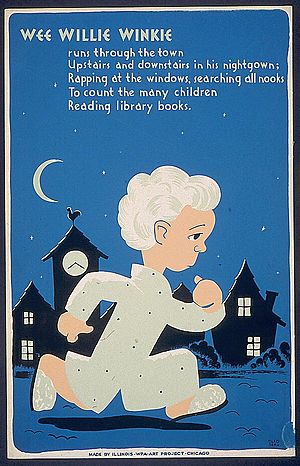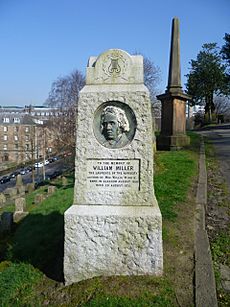Wee Willie Winkie facts for kids
Quick facts for kids "Wee Willie Winkie" |
|
|---|---|

1940 WPA poster using Wee Willie Winkie to promote children's libraries
|
|
| Nursery rhyme | |
| Language | Scots |
| Published | 1841 |
| Lyricist(s) | William Miller |
"Wee Willie Winkie" is a well-known Scottish nursery rhyme. Its main character has become famous worldwide. He is often seen as a symbol of sleep. The poem was written by William Miller. It was first called "Willie Winkie." It appeared in a book named Whistle-binkie: Stories for the Fireside in 1841. This rhyme has a special number, 13711, in the Roud Folk Song Index. This index helps keep track of folk songs.
Contents
The Story of Wee Willie Winkie
The rhyme tells about a little character named Wee Willie Winkie. He runs through the town at night. He goes up and down stairs in his night-gown. He checks on children to see if they are in bed. He taps on windows and calls through locks. He wants to know if "the weans" (children) are asleep. This is because it is already ten o'clock.
Who Was William Miller?
William Miller was a Scottish poet. He was born in 1810 and passed away in 1872. He is best known for writing "Wee Willie Winkie." He wrote many poems for children. His work often captured the spirit of Scottish life. The rhyme quickly became popular. It helped children understand bedtime routines.
What Does the Rhyme Mean?
The poem describes a child who does not want to sleep. This child is "waukrife" (wakeful). He is "glow'ring like the moon" and making noise. He rattles an iron jug and crows like a cock. Wee Willie Winkie is called to help. He is supposed to make the child finally fall asleep. The rhyme shows how tired a mother can be. She has a "stoorie wean" (dusty child) who fights sleep. But a kiss from the child makes her feel strong again.
The Original Lyrics
The original poem was written in Scots. This is a language spoken in Scotland. Below, you can see the original Scots version. Next to it is a version translated into English. This English version was made in 1844. It helps more people understand the rhyme.
|
Wee Willie Winkie rins through the toon, |
Wee Willie Winkie runs through the town, |



